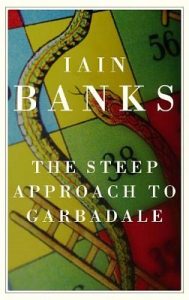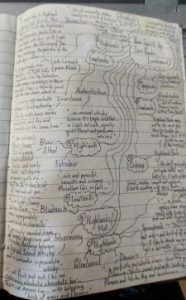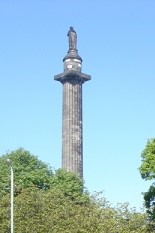
From wikipedia.com / © Tim Duncan
Ten years ago today, on June 9th, 2013, the Scottish novelist Iain Banks passed away at the age of 59, struck down by a gall-bladder cancer that’d only been diagnosed two months earlier. Here’s a slightly updated version of the tribute to him I wrote at the time.
Iain Banks became a big thing for me, and for many people like me, when he found success, fame and a certain notoriety with the publication of his first novel, The Wasp Factory, in 1984. This was because he seemed to tick a lot of important boxes.
Like me and the crowd I hung out with, he came from a Scottish background, so we were familiar with many of the places he wrote about. Like us, his politics were left-of-centre, with a leaning towards the cause of Scottish independence because independence seemed the best way to avoid being saddled with right-wing Tory governments whom few people in Scotland ever voted for. And like us, he was obviously into literature, but he was also into some strange, off-beat writers whom stuffy literary critics would dismiss as being too ‘genre’ for serious consideration – Mervyn Peake, Brian Aldiss, M. John Harrison, and so on.
You could argue that Alasdair Gray had blazed the same trail a few years earlier with his 1980 novel Lanark, but there was one important difference. Gray had been a young man in the 1950s. Banks, like us, was clearly of the 1980s. Like it or not – and we did not – Banks and us, his readers, were Maggie Thatcher’s children.
The Wasp Factory made an immediate stir with its blackly funny plot about Frank Cauldhame, a maimed delinquent living in a remote part of Scotland, who amuses himself with the shamanistic killings of insects, seagulls, rabbits and young children. In quick succession Banks followed it with Walking on Glass (1985), which showed the influence of Mervyn Peake’s Gormenghast books (1946-59); The Bridge (1986), a paean to both the Forth Rail Bridge and Gray’s Lanark, with a healthy dose of the J.G. Ballard short story Concentration City (1957) mixed in; and in 1987 Consider Phlebas, the first of many epic outer-space novels about an interstellar anarcho-utopian society called the Culture. The Culture novels were attributed to Iain M. Banks, a move by his publisher to help fans of ‘serious’ mainstream fiction and fans of science fiction identify what was what in his output. At the time, the speculative fiction magazine Interzone remarked that it was delighted to see Banks at last ‘come out of the closet’ as a sci-fi writer.
In August 1987 Banks was scheduled to appear on a discussion panel at the Edinburgh Book Festival. Around the same time I’d agreed to edit the latest edition of a small literary magazine called Alma Mater, published by some fellow-students at the University of Aberdeen’s English Literature Department. Dr Isobel Murray, who’d been my tutor at Aberdeen for the past year, was chairing the Book Festival panel and I used my connection with her to persuade Banks’s agent to let me interview him after the panel, for Alma Mater. I later offered Dr Murray a grovelling apology for brazenly using her name as my calling card.

© Abacus Books
The panel, which I attended, produced a few sparks. In addition to Banks and Murray, it featured the Glaswegian writer Frederic Lindsay, whose 1983 novel Brond had recently been made into a TV series, directed by Michael Caton-Jones and starring a very young John Hannah. (By a sad coincidence, Lindsay also died in 2013, just ten days before Banks did.) And it was rounded off by another Glaswegian, Ronald Frame, author of the just-published novel Sandmouth People. If it’s unfair to say that the tweedy Frame was a young fogey at the time, he certainly gave the impression of being one. When somebody in the audience asked the authors about their views on self-censorship, he said pompously: “I would never include anything I might regret in five years’ time.”
Banks immediately spluttered, “But those are the best bits!”
Afterwards I met up with Banks and a few of his friends and conducted the interview in a pub in Edinburgh’s Rose Street – either the Kenilworth or the Auld Hundred, if I remember correctly – with Banks speaking into the mic of the clunky tape recorder I’d bought with me, transferring his voice onto a crackly cassette tape that, like almost everything else I possess, now resides inside a cardboard box somewhere in my Dad’s attic.
I asked him about the hostile reception that The Wasp Factory had received in some quarters. (The Irish Times had described it as ‘a work of unparalleled depravity’.) Banks had been surprised by this. He’d expected some flak from animal rights groups, but not from the critics. He’d learned that one reviewer who’d blasted the book as ‘the literary equivalent of a video nasty’ also worked in the Conservative Party office in London, which pleased him no end. Offending that guy had been an honour.
I also asked him about his fondness for peppering his novels with references to the popular culture of the time. In The Bridge, for example, just before the car accident that sets the surreal plot in motion, the hero slots a copy of the Pogues album Rum, Sodomy and the Lash (1985) into his car stereo. Wouldn’t that make the books look rather dated a few years later? “Yeah,” he agreed, “it’ll date them. But what the hell?” He believed that characters living in a particular time and particular place would be influenced by the current popular culture, so he didn’t see why he should shirk from mentioning the music, books, films and TV programmes of the moment.
I quoted Brian Aldiss at him – Aldiss had famously said that all good science fiction hovers at the edge of being something different from science fiction. Banks agreed with that, sort of, but he also disagreed. Enthusiastically, he told me how Consider Phlebas came with all the trimmings of the traditional Isaac Asimov / Robert Heinlein ‘space opera’: giant spaceships, laser cannons, inter-planetary battles.

© Little, Brown
Did he, I asked finally, worry about being pigeon-holed, with one half of the world viewing him as a ‘Scottish’ author and the other half viewing him as a ‘sci-fi’ one? Not at all, he said. He was quite at ease with being regarded as Scottish. And being seen as a sci-fi author didn’t bother him either, since science fiction was an ‘old love’ for him.
From Rose Street, we moved to Greyfriars Bobby’s Bar in Candlemaker Row, just behind the statue of the famous Edinburgh terrier who’d spent 14 years in the adjacent graveyard guarding the grave of his dead master. Poor wee Bobby, I remember musing, wouldn’t have lasted long if he’d been a character in The Wasp Factory. By then a good number of pints had been drunk and the conversation had descended somewhat from the lofty heights of literary discussion. I recall talking to Banks about Arthur Montford, the lugubrious Scottish TV football commentator famous for his eccentrically patterned sports jackets and for his catchphrases that included “What a stramash!” and (uttered all too often) “Disaster for Scotland!” At some point too we discussed the 1966 Hammer horror film Dracula Prince of Darkness, which had featured the Scottish actor (from Shotts in North Lanarkshire) Andrew Keir.
The next issue of Alma Mater, containing my interview with Iain Banks, was published later that year. A series of cock-ups by the typesetter meant that it looked pretty ropey, though thankfully the pages featuring Banks were okay. The following year, I heard that Banks would be making an appearance at Edinburgh’s Science Fiction Bookshop in West Crosscauseway (now long vanished) and I went along to give him a copy of the magazine. To my surprise, he remembered me and enthused about the mini-pub crawl we’d done that day: “That was a good afternoon!”
After that I read several more Banks novels: Espedair Street (1987), Canal Dreams (1989), The Crow Road (1992), Complicity (1993). The Crow Road, his stab at writing a sprawling family saga, is the book that everyone talks about, although I have to say that it’s not one of my favourites. Sure, it has one of the best opening lines in modern literature (“It was the day my grandmother exploded”), but as with most other sprawling sagas about eccentric families, I find it too contrived for its own good.

© Little, Brown
On the other hand, I think Espedair Street, which is about a hapless rock musician who’s found fame, fortune and much unhappiness and is now trying to live anonymously in a rough part of Glasgow, is marvellous. I also think it’s the warmest and most relatable Iain Banks book that I’ve read. Among my all-time favourite novels about rock ‘n’ roll, it’s up there with Harlan Ellison’s Spider Kiss (1961) and John Niven’s Kill Your Friends (2008).
And I like Complicity, which welds a serial-killer plot onto Banks’ intense distaste for the corruption and inequalities of the recently-ended Thatcher era. Much of it is set in Edinburgh, where scuzzy journalist-hero Cameron Colley boozes in a series of pubs ranging from the upmarket Café Royal on West Register Street to the desperate, late-opening Casbah in the Cowgate. By then I’d lived in Edinburgh and I knew Colley’s haunts well. I’d even had an experience similar to one he has in the Café Royal, when he stands in front of the bar’s gantry (which doesn’t contain a mirror although it looks as though it does), can’t see his reflection and in a drunken panic believes himself to be a vampire.
After Complicity, however, I stopped reading Iain Banks, probably because by then there were just too many young Scottish writers competing for my attention: Irvine Welsh, Alan Warner, James Robertson. Banks’s success in the 1980s, of course, had helped pave the way for all these slightly younger Turks. It wasn’t until after his death that I read more of his stuff: the collection State of the Art (1991), whose stories lean towards science fiction, so the name ‘Iain Banks’ on the cover contains that all-important initial-letter ‘M’ to warn readers of serious mainstream literature to keep clear; The Steep Approach to Garbadale (2007); Stonemouth (2012); The Quarry, published posthumously in 2013; and Banks’s one book of non-fiction, Raw Spirit (2003), which details his experiences while he works on the rather enviable assignment of visiting, and sampling the products of, as many of Scotland’s whisky distilleries as he can.
Among these later novels, The Steep Approach to Garbadale, another sprawling family saga, perhaps sticks most in my mind. That’s largely because of the following quote, wherein the narrator muses on the connection between being right-wing and not having an imagination, and which could be the manifesto for Banks’s own politics: “We got talking about how some people were selfish and some weren’t, and the difference between right-wing people and left-wing people. You said it all came down to imagination. Conservative people don’t usually have very much, so they find it hard to imagine what life is like for people who aren’t just like them. They can only empathise with people just like they are: the same sex, the same age, the same class, the same golf club or nation or race or whatever. Liberals can pretty much empathise with anybody else, no matter how different they are. It’s all to do with imagination, empathy and imagination are almost the same thing, and it’s why artists, creative people, are almost all liberals, left-leaning.”
Meanwhile, I found Raw Spirit so informative that, as I read it, I tried to record what it said about the distilleries Banks visited, the whiskies he drank, and his opinions on their flavours, in a series of mind-maps.


Banks was so prolific that, looking at his bibliography, I see there are still nearly 20 books of his that I haven’t read yet. That includes the entire series of Culture novels. So, I still have much catching up to do with the great man’s oeuvre.








